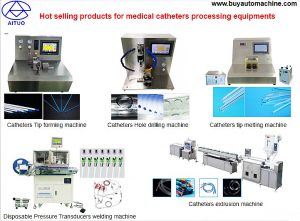Maintaining a medical catheter machine is critical to ensure that it operates efficiently, produces high-quality catheters, and remains safe to use. Proper maintenance also extends the life of the machine, reduces downtime, and prevents costly repairs. In this article, we will discuss several steps that can be taken to maintain a medical catheter machine.
1.Perform Regular Inspections
Regular inspections are essential to identify any potential issues with the machine before they turn into more significant problems. Inspections should be performed daily, weekly, and monthly, depending on the frequency of machine use. The inspection should cover all areas of the machine, including the mechanical, electrical, and hydraulic systems.
2.During inspections, it’s essential to check for any loose or damaged components, worn parts, or signs of wear and tear. It’s also important to ensure that all safety devices, such as guards and interlocks, are functioning correctly. Any identified issues should be addressed immediately, and damaged parts should be replaced promptly.
3.Keep the Machine Clean
Keeping the machine clean is essential to maintain its efficiency and prolong its life. The machine should be cleaned regularly, especially after extended periods of use. The cleaning should include wiping down all surfaces, removing any debris or dust, and cleaning the catheter molds.
It’s also important to ensure that the machine’s cooling system is functioning correctly and that the coolant is replaced regularly. Dirty coolant can cause clogging and result in overheating, which can damage the machine’s components.
4.Lubricate Moving Parts
Proper lubrication is critical to maintain the machine’s moving parts and prevent wear and tear. The machine’s manufacturer should provide instructions on which lubricants to use and how often to apply them. Lubrication should be performed regularly, and any excess lubricant should be removed to prevent contamination of the catheters.
5.Calibrate the Machine
Calibrating the machine ensures that it produces catheters of the correct size and specifications. The machine should be calibrated regularly, following the manufacturer’s guidelines. Calibration typically involves adjusting the machine’s settings, such as temperature, pressure, and speed, to ensure that they are within the specified range.
6.Train Personnel Properly
Properly trained personnel are critical to maintaining a medical catheter machine correctly. The machine’s manufacturer should provide training on how to operate, maintain, and troubleshoot the machine. All personnel who operate the machine should be trained on the proper use of the machine, including safety procedures, and how to perform routine maintenance tasks.
7. Keep Records
Keeping accurate records of all maintenance performed on the machine is essential for identifying any patterns of issues and determining when maintenance is due. Records should include the date and nature of the maintenance performed, any parts replaced, and any issues identified. These records should be easily accessible and kept up to date

In conclusion, maintaining a medical catheter machine requires regular inspections, cleaning, lubrication, calibration, proper training, and record-keeping. These steps are critical to ensuring that the machine operates efficiently, produces high-quality catheters, and remains safe to use. By following these steps, manufacturers can extend the life of their machines, reduce downtime, and prevent costly repairs.


